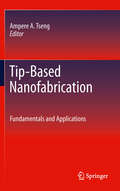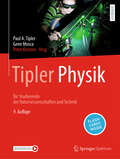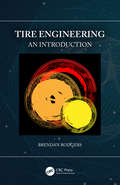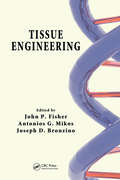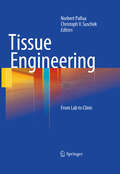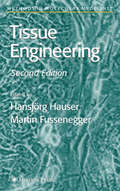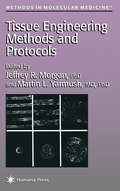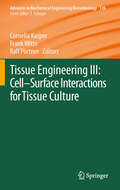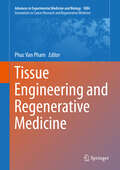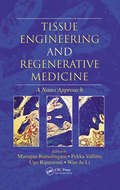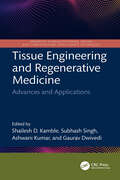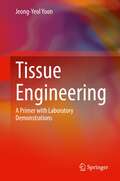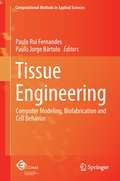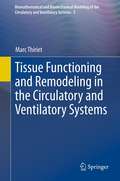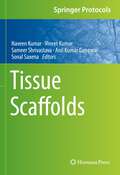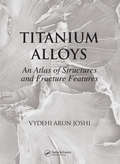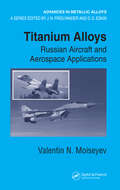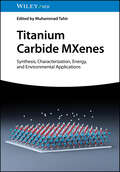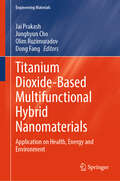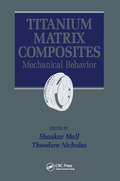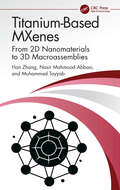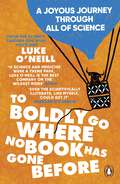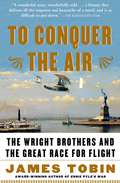- Table View
- List View
Tip-Based Nanofabrication
by Ampere A. TsengNanofabrication is critical to the realization of potential benefits in the field of electronics, bioengineering and material science. One enabling technology in nanofabrication is Tip-Based Nanofabrication, which makes use of functionalized micro-cantilevers with nanoscale tips. Tip-Based Nanofabrication: Fundamentals and Applications discusses the development of cantilevered nanotips and how they evolved from scanning probe microscopy and are able to manipulate environments at nanoscale on substrates generating different nanoscale patterns and structures. Also covered are the advantages of ultra-high resolution capability, how to use tip based nanofabrication technology as a tool in the manufacturing of nanoscale structures, single-probe tip technologies, multiple-probe tip methodology, 3-D modeling using tip based nanofabrication and the latest in imaging technology.
Tipler Physik: für Studierende der Naturwissenschaften und Technik
by Paul A. Tipler Gene MoscaTipler Physik dient bereits Generationen von Studierenden der Natur- und Ingenieurwissenschaften als Lern-, Lehr- und Nachschlagewerk. Angehende oder sich bereits im Studium befindliche Bachelorstudierende mit Physik, Ingenieurwissenschaften oder verwandter Gebiete, egal ob im Haupt- oder Nebenfach profitieren von ausführlichen und leicht nachvollziehbaren Erklärungen. Schritt für Schritt werden Beispiele vorgerechnet, zusätzlich oft auch mithilfe der Software MATLAB®. Zudem werden die physikalischen Inhalte mit wertvollen Tipps und Tricks vervollständigt. Alle Gebiete der Physik werden behandelt und zwar genau richtig – nicht zu viel um einen guten Einstieg zu ermöglichen und nicht zu wenig, um einen soliden Überblick zu erhalten. Damit ist Tipler Physik ein treuer Begleiter durch das Studium und auch danach. Gleichzeitig trägt das Buch neuen Entwicklungen Rechnung. Digitale Karteikarten, die in dieser Auflage neu hinzugekommen sind, ermöglichen das flexible Lernen und Vertiefen überall. Am Ende jedes Kapitels findet ein Ein- und Ausblick in die aktuelle Forschung statt.Wer im Studium, Schule oder Beruf sich mit physikalischen Fragestellungen befasst, dem sollte Tipler Physik in Bücherregal nicht fehlen: · didaktisch wertvoll aufbereitet und dargestellt· zahlreiche Beispiel- und Übungsaufgaben mit Schritt-für-Schritt Anleitungen bzw. Lösungen· digitale Karteikarten in Form der SN Flashcards· Einführung in MATLAB® anhand konkreter Aufgabenstellungen· bewährte Tipps und Tricks, um nicht in die Fehlerfalle zu geraten· wichtigste Gesetze und Formeln kurz zusammengefasst· übersichtliche und anschauliche Abbildungen· aktuelle Forschungsbeiträge, die in den Kontext zu ihrem Fachgebiet gestellt werden.
Tire Engineering: An Introduction
by Brendan RodgersThe modern tire is the most complex, composite product in mass production. Yet given its complexity and required performance, there is little information in the public domain regarding its development. This book provides an introduction to tire design, construction, and manufacturing in the context of materials technologies used today, along with future trends and disrupting technologies. Focuses on design and construction Discusses the relationship between materials and performance Reviews tire uniformity as a key differentiator among manufacturers Evaluates design and construction features versus performance Written for engineers in the polymer, industrial, chemical, mechanical, and automotive industries, this book offers a comprehensive view of tire design, including materials selection, construction, manufacturing, quality control, and future trends.
Tissue Engineering
by Joseph D. Bronzino John P. Fisher Antonios G. MikosIncreasingly viewed as the future of medicine, the field of tissue engineering is still in its infancy. As evidenced in both the scientific and popular press, there exists considerable excitement surrounding the strategy of regenerative medicine. To achieve its highest potential, a series of technological advances must be made. Putting the numerous
Tissue Engineering
by Norbert Pallua Christoph V. SuschekTissue engineering is a multidisciplinary field incorporating the principles of biology, chemistry, engineering, and medicine to create biological substitutes of native tissues for scientific research or clinical use. Specific applications of this technology include studies of tissue development and function, investigating drug response, and tissue repair and replacement. This area is rapidly becoming one of the most promising treatment options for patients suffering from tissue failure. This abundantly illustrated and well-structured guide serves as a reference for all clinicians and researchers dealing with tissue engineering issues in their daily practice.
Tissue Engineering
by Martin M. Fussenegger Hansjörg HauserThis book provides a comprehensive volume that integrates a wide spectrum of methods required to implement current and future progress in tissue engineering. Leading experts in various disciplines provide examples of recent advances in tissue engineering-related methodologies. Authors present authoritative discussions on topics. The book supplies an understanding of diverse technologies and methods used to drive tissue engineering into a clinical reality. The knowledge contained in this volume represents the impressive progress made in the decade when tissue engineering rapidly evolved.
Tissue Engineering
by Jeffrey R. Morgan Martin L. YarmushThe first major collection of cutting-edge methods developed and used by leading researchers in the tissue engineering field. These hands-on experts describe easily reproducible protocols for the production and evaluation of polymers, scaffolds, and composites, as well as methods for the isolation, culture, and analysis of cells, including the combination of cells with a variety of materials or devices. Quantitative methods designed to assess cell performance and cell function that will also illuminate our understanding of cellular processes and the cellular response to the chemical and mechanical environment of a functional organ/tissue are also offered.
Tissue Engineering And Novel Delivery Systems
by Vasif Hasirci Kai-Uwe Lewandrowski Debra J. Trantolo Michael J. Yaszemski Donald L. Wise David E. AltobelliEssential to anyone working in the field, this reference focuses on latest advancements in tissue construction, repair and regeneration focusing on developments in gene and drug therapy, the evolution of tissue-engineered products, and new technologies for the design of functional tissues and organ systems.
Tissue Engineering III: Cell - Surface Interactions for Tissue Culture
by Ralf Pörtner Cornelia Kasper Frank WitteThe Cell-Surface Interaction, by J. S. Hayes, E. M. Czekanska and R. G. Richards. Studying Cell-Surface Interactions In Vitro: A Survey of Experimental Approaches and Techniques, by Stefanie Michaelis, Rudolf Robelek and Joachim Wegener. Harnessing Cell-Biomaterial Interactions for Osteochondral Tissue Regeneration, by Kyobum Kim, Diana M. Yoon, Antonios G. Mikos and F. Kurtis Kasper. Interaction of Cells with Decellularized Biological Materials, by Mathias Wilhelmi, Bettina Giere and Michael Harder. Evaluation of Biocompatibility Using In Vitro Methods: Interpretation and Limitations, by Arie Bruinink and Reto Luginbuehl. Artificial Scaffolds and Mesenchymal Stem Cells for Hard Tissues, by Margit Schulze and Edda Tobiasch. Bioactive Glass-Based Scaffolds for Bone Tissue Engineering, by Julia Will, Lutz-Christian Gerhardt and Aldo R. Boccaccini. Microenvironment Design for Stem Cell Fate Determination, by Tali Re'em and Smadar Cohen. Stem Cell Differentiation Depending on Different Surfaces, by Sonja Kress, Anne Neumann, Birgit Weyand and Cornelia Kasper. Designing the Biocompatibility of Biohybrids, by Frank Witte, Ivonne Bartsch and Elmar Willbold. Interaction of Cartilage and Ceramic Matrix, by K. Wiegandt, C. Goepfert, R. Pörtner and R. Janssen. Bioresorption and Degradation of Biomaterials, by Debarun Das, Ziyang Zhang, Thomas Winkler, Meenakshi Mour, Christina I. Günter, Michael M. Morlock, Hans-Günther Machens and Arndt F. Schilling.
Tissue Engineering and Regenerative Medicine (Advances in Experimental Medicine and Biology #1084)
by Phuc Van PhamThis new series, based on a bi-annual conference and its topics, represents a major contribution to the emerging science of cancer research and regenerative medicine. Each volume brings together some of the most pre-eminent scientists working on cancer biology, cancer treatment, cancer diagnosis, cancer prevention and regenerative medicine to share information on currently ongoing work which will help shape future therapies. These volumes are invaluable resources not only for already active researchers or clinicians but also for those entering these fields, plus those in industry. Tissue Engineering and Regenerative Medicine is a proceedings volume which reflects papers presented at the 3rd bi-annual Innovations in Regenerative Medicine and Cancer Research conference; taken with its companion volume Stem Cells: Biology and Engineering it provides a complete overview of the papers from that meeting of international experts.
Tissue Engineering and Regenerative Medicine: A Nano Approach
by Murugan Ramalingam Ugo Ripamonti Pekka Vallittu Wan-Ju LiThrough the integration of strategies from life science, engineering, and clinical medicine, tissue engineering and regenerative medicine hold the promise of new solutions to current health challenges. This rapidly developing field requires continual updates to the state-of-the-art knowledge in all of the aforementioned sciences. Tissue Engineering
Tissue Engineering and Regenerative Medicine: Advances and Applications (Advances in Manufacturing, Design and Computational Intelligence Techniques)
by Ashwani Kumar Subhash Singh Gaurav Dwivedi Shailesh D. KambleThe book emphasizes the technological advancements in tissue engineering related to biomaterials and biomanufacturing techniques. It further discusses important topics such as 3D bioprinting, process parameter optimization, Convolutional Neural Network (CNN) for stem cell imaging, diabetes risk prediction and Parkinson’s disease detection using machine learning, telehealth systems, acute pancreatitis, and data-driven monitoring of chronic diseases.This book: Explores the role of artificial intelligence in designing biomaterials, optimizing fabrication processes, and predicting tissue formation Focuses on technological advancements in tissue engineering related to biomanufacturing techniques, and biomaterials Discusses the denture base acrylic resins, brain tumor detection, CNN for stem cell imaging and machine learning for diabetes risk prediction and Parkinson’s disease detection. Covers acute myocardial infarction, post-operative urinary retention, telehealth systems, graph convolutional network, and acute pancreatitis. Explains the role of serum magnesium levels in febrile convulsions and Apache-II Score and Ranson Criteria with Modified CT Severity Index. It is primarily written for senior undergraduates, graduate students, and academic researchers in the fields of manufacturing engineering, biomedical engineering, materials science, biomaterials, mechanical engineering, and production engineering.
Tissue Engineering: A Primer with Laboratory Demonstrations
by Jeong-Yeol YoonTissue Engineering: A Primer with Laboratory Demonstrations concisely covers the fundamental basics of tissue engineering. A series of simple, low-cost, and easy-to-implement laboratory modules are included in each chapter, along with experimental results with actual images and data, and a set of questions and discussion topics for each laboratory exercise. The textbook is appropriate for upper-undergraduate and graduate-level courses in cell and tissue engineering. The inclusion of images and data for all laboratory exercises also makes the book a valuable tool for scientists and engineers to learn the concepts in a hands-on and visual manner and lay a foundation to build their experiments towards their research and commercial development.
Tissue Engineering: Computer Modeling, Biofabrication and Cell Behavior
by Paulo Jorge Bártolo Paulo Rui FernandesThis book describes the state of the art on computational modeling and fabrication in Tissue Engineering. It is inspired by the ECCOMAS thematic conference, the European Committee on Computational Methods in Applied Sciences, on Tissue Engineering, held in Lisbon, Portugal, June 2-4, 2011. Tissue Engineering is a multidisciplinary field involving scientists from different fields. The development of mathematical methods is quite relevant to understand cell biology and human tissues as well to model, design and fabricate optimized and smart scaffolds. Emphasis is put on mathematical and computational modeling for scaffold design and fabrication. This particular area of tissue engineering, whose goal is to obtain substitutes for hard tissues such as bone and cartilage, is growing in importance.
Tissue Engineering: Principles, Protocols, and Practical Exercises (Learning Materials in Biosciences)
by Narine SarvazyanTissue engineering and regenerative medicine is a new, interdisciplinary branch of science that combines knowledge from numerous scientific fields including biology, biochemistry, physics, chemistry, applied engineering, and medicine. It aims to restore damaged parts of the human body by rebuilding them in vitro using individual building blocks of biological tissues such as cells and the extracellular matrix that surrounds them. The authors hope to spark students’ interest in this exciting new field of science as well as give them a basic knowledge of its terminology.This book is based on a hands-on practical course in tissue engineering conducted by the Fulbright US Scholar recipient, Dr. Narine Sarvazyan (George Washington University, Washington USA). It provides an overview of the core topics of the tissue engineering field, including stem cell differentiation, the role of extracellular matrix and attachment proteins, scaffolds, and culturing of engineered tissues. Each chapter is accompanied by hands-on demonstrations and self-check questions. The text is easily readable for students of all backgrounds and the described protocols can be conducted using common lab equipment. This textbook is also useful for developing undergraduate and graduate courses that teach basic methods and approaches in this promising and rapidly developing field.
Tissue Functioning and Remodeling in the Circulatory and Ventilatory Systems
by Marc ThirietThe volumes in this authoritative series present a multidisciplinary approach to modeling and simulation of flows in the cardiovascular and ventilatory systems, especially multiscale modeling and coupled simulations. Volume 5 is devoted to cells, tissues, and organs of the cardiovascular and ventilatory systems with an emphasis on mechanotransduction-based regulation of flow. The blood vessel wall is a living tissue that quickly reacts to loads applied on it by the flowing blood. In any segment of a blood vessel, the endothelial and smooth muscle cells can sense unusual time variations in small-magnitude wall shear stress and large-amplitude wall stretch generated by abnormal hemodynamic stresses. These cells respond with a short-time scale (from seconds to hours) to adapt the vessel caliber. Since such adaptive cell activities can be described using mathematical models, a key objective of this volume is to identify the mesoscopic agents and nanoscopic mediators required to derive adequate mathematical models. The resulting biomathematical models and corresponding simulation software can be incorporated into platforms developed in virtual physiology for improved understanding and training.
Tissue Scaffolds (Springer Protocols Handbooks)
by Vineet Kumar Naveen Kumar Sameer Shrivastava Anil Kumar Gangwar Sonal SaxenaThis volume provides a comprehensive introduction into methods and procedures on the preparation and characterization of animal tissue-derived extracellular matrix scaffolds primarily from bubaline, caprine, porcine, ovine, rabbit, rat and fish source. Chapters guide readers through decellularization protocol unique to the particular animal tissue and animal studies outcomes. Authoritative and cutting-edge, Tissue Scaffolds aims to be a useful and practical guide to new researchers and experts looking to expand their knowledge.
Titanium Alloys: An Atlas of Structures and Fracture Features
by Vydehi Arun JoshiRecognized for their superior strength, corrosion/oxidation resistance, and biocompatibility, titanium alloys are particularly intriguing to engineers, scientists, and metallurgists in aerospace, biomedical, and other industrial applications. Titanium Alloys: An Atlas of Structures and Fracture Features uses award-winning micrographs and fra
Titanium Alloys: Russian Aircraft and Aerospace Applications (Advances in Metallic Alloys #Vol. 5)
by Valentin N. MoiseyevThis text offers previously elusive information on state-of-the-art Russian metallurgic technology of titanium alloys. It details their physical, mechanical, and technological properties, as well as treatments and applications in various branches of modern industry, particularly aircraft and aerospace construction. Titanium Alloys: Russian Aircraft
Titanium Carbide MXenes: Synthesis, Characterization, Energy and Environmental Applications
by Muhammad TahirTitanium Carbide MXenes Discover the future of solar energy with this introduction to an essential new family of materials MXenes are a recently-discovered family of two-dimensional organic compounds formed from transition metal carbides. Their unique properties, such as high stability and electron conductivity, have made them a sought-after commodity with many industrial applications in cutting-edge industries. In particular, titanium carbide MXenes look poised to have significant applications in the solar energy industry, with potentially revolutionary consequences for the sustainable energy future. Titanium Carbide MXenes offers a thorough and accessible introduction to this family of compounds and their possible applications. It begins by surveying the fundamentals of the MXene groups, before characterizing titanium carbide MXenes and their processes of synthesis. It then moves on to discuss applications, current and future. The result is a must-read for researchers and professionals looking to synthesize and construct these materials and apply them in sustainable industry. Titanium Carbide MXenes readers will also find: Detailed treatment of MXenes including nitrides composites, perovskites composites, and more Discusses applications in photocatalytic CO2 reduction, hydrogen production, water splitting, and more Roughly 100 figures illustrating key concepts Titanium Carbide MXenes is a must-have for materials scientists, catalytic chemists, and scientists in industry.
Titanium Dioxide-Based Multifunctional Hybrid Nanomaterials: Application on Health, Energy and Environment (Engineering Materials)
by Dong Fang Jai Prakash Junghyun Cho Olim RuzimuradovThis book provides a comprehensive look at titanium dioxide (TiO₂) semiconductor nanomaterials, covering their synthesis, unique properties, and applications across energy, environmental, and biomedical fields. From fundamental optical and electronic properties to the design of hybrid TiO₂ materials, it explores their role as multifunctional photocatalysts, pivotal in solar cells, hydrogen production, and lithium-ion batteries. Environmental applications are emphasized through TiO₂’s effectiveness in pollutant degradation, CO₂ reduction, and water purification, while biomedical uses include antibacterial functions and biosensing technologies relevant to diagnostics and even COVID-19 studies. With a focus on current advancements and future potential, this book is an essential resource for researchers and industry professionals exploring TiO₂ nanomaterials' diverse scientific and technological impacts.
Titanium Matrix Composites: Mechanical Behavior
by Shankar Mall Theodore NicholasA review and summary of advancements related to mechanical behavior and related mechanics issues of titanium matrix composites (TMCs), a class of high-temperature materials useful in the propulsion and airframe components in advanced aerospace systems. After an introduction to TMCs, different authors review and summarise the advancements related to mechanical behavior and related mechanics issues of TMCs.
Titanium-Based MXenes: From 2D Nanomaterials to 3D Macroassemblies
by Muhammad Tayyab Han Zhang Nasir Mahmood AbbasiThis book explores titanium-based MXenes, an emergent class of materials with a broad range of properties and potential applications. It introduces 3D MXene assemblies and compares their properties with such other well-known two-dimensional materials as graphene and transition metal dichalcogenides.Features:• Focuses on emerging 2D titanium-based MXene (Ti3C2Tx and Ti2CTx) materials.• Offers detailed synthetic strategies and scalable approaches.• Covers defect engineering and physical properties.• Compares the uniqueness of 2D titanium-based MXene with other 2D-layered materials.• Discusses 3D macrostructure of titanium-based MXenes and their practical application in photodetectors, catalysis energy storage devices, and biomedicines.The first comprehensive book on the subject, this work is aimed at researchers in materials and electrical engineering and related disciplines.
To Boldly Go Where No Book Has Gone Before: A Joyous Journey Through All of Science
by Luke O'NeillScience is a serious business, right? Wrong. Scientists have been participants in the best reality show of all time, with all the highs, lows, bust-ups, and strange personalities of any show on telly today. From Luke O'Neill - the science teacher you wish you'd had - this hugely accessible history of science reveals the human stories behind the biggest discoveries.For example, we meet Charles Darwin as he weighs up the pros and cons of marrying his cousin: 'constant companion' vs 'less money for books'. Tough call.To Boldly Go Where No Book Has Gone Before covers everything from space travel and evolution to alchemy and AI. Written by one of our leading scientists, this is an insider's account that celebrates the joy of science. It is filled with all the juicy bits that other histories leave out.
To Conquer the Air: The Wright Brothers and the Great Race for Flight
by James TobinJames Tobin, award-winning author of Ernie Pyle's War and The Man He Became, has penned the definitive account of the inspiring and impassioned race between the Wright brothers and their primary rival Samuel Langley across ten years and two continents to conquer the air.For years, Wilbur Wright and his younger brother, Orville, experimented in obscurity, supported only by their exceptional family. Meanwhile, the world watched as Samuel Langley, armed with a contract from the US War Department and all the resources of the Smithsonian Institution, sought to create the first manned flying machine. But while Langley saw flight as a problem of power, the Wrights saw a problem of balance. Thus their machines took two very different paths--Langley's toward oblivion, the Wrights' toward the heavens--though not before facing countless other obstacles. With a historian's accuracy and a novelist's eye, Tobin has captured an extraordinary moment in history. To Conquer the Air is itself a heroic achievement.
